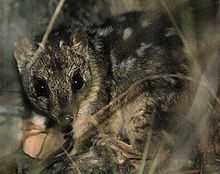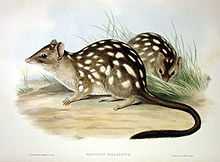Northern quoll
| Northern quoll[1] | |
|---|---|
 | |
| In Queensland, Australia | |
| Conservation status | |
| Scientific classification | |
| Kingdom: | Animalia |
| Phylum: | Chordata |
| Class: | Mammalia |
| Infraclass: | Marsupialia |
| Order: | Dasyuromorphia |
| Family: | Dasyuridae |
| Genus: | Dasyurus |
| Species: | D. hallucatus |
| Binomial name | |
| Dasyurus hallucatus Gould, 1842 | |
| | |
| Northern quoll range | |
The northern quoll (Dasyurus hallucatus), also known as the northern native cat, the satanellus, the North Australian native cat or the njanmak (in the indigenous Mayali language), is a carnivorous marsupial native to Australia.
Taxonomy
The northern quoll is a member of the family Dasyuridae, and is often stated to be the most distinctive Australian quoll. It was first described in 1842 by naturalist and author John Gould, who gave it the species name hallucatus, which indicates it has a notable first digit. This species has sometimes been placed in a separate genus, Satanellus.
Life history
The northern quoll is the smallest of the four Australian quoll species.[3] Females are smaller than males, with adult females weighing between 350 and 690 g and adult males 540 and 1120 g. Head and body length ranges from 270–370 mm (adult males) to 249–310 mm (adult females). Tail length ranges between 202 and 345 mm.
Northern quolls feed primarily on invertebrates, but also consume fleshy fruit (particularly figs), and a wide range of vertebrates, including small mammals, birds, lizards, snakes, and frogs. They also scavenge on road-kills, around campsites, and in garbage tins.
A remarkable feature of this species is that the males show complete die-off after mating, leaving the females to raise the young alone. Females have eight teats in a pouch, but apparently give birth to more than eight young which must wriggle their way to the pouch and compete for a teat to survive.[4] In a study in Western Australia's Kimberley region, the testosterone levels of males peaked in July, and females gave birth in July or August.[5]
In the wild, males live for about one year, while the maximum recorded for a wild female was about three years of age.[3] In rocky habitats, the lifespan of both sexes appears to be increased to two or three years, and individuals are larger than those living in savanna habitats, possibly due to better habitat and reduced predation.[3]
Range and habitat
The northern quoll occurs from the Pilbara region of Western Australia across the Northern Territory to south east Queensland. Their historical range extended uninterrupted from S.E Queensland to the Kimberleys in Western Australia.[6] There are several disjunct populations. This quoll species is most abundant in rocky ranges and open eucalypt forest.
Conservation status

The northern quoll is now absent from many parts of its former range. It has recently been listed as Endangered under Australian Commonwealth legislation (EPBC Act), although it is listed as Near Threatened by the IUCN. Its current major threat is the spread of cane toads, which were originally introduced in Queensland, but have now occupied the Top End of the Northern Territory, including Kakadu National Park and the Darwin area, and entered the Kimberley region of Western Australia, where they are established around Kununurra and Lake Argyle.
Other threats are predation by feral cats and foxes, and the destruction, degradation, and fragmentation of the quoll's habitat due to changed fire regimens, mining, land clearing, pasture improvement, and grazing.[3] Quolls are also susceptible to being run over on roads.[3]
In two Kakadu study sites, quolls have become extinct at one site and declined from 45 individuals to five at the other site. The northern quoll may cease to exist in most areas in the Top End once the cane toad population completely overlaps the northern quoll's range. Remnant populations of northern quolls still persist in Queensland where cane toads have been present for many years. Scientists do not yet understand the mechanism for their persistence.
The increasing spread of the cane toad throughout Australia is becoming a significant factor in the dramatic decline in numbers for the northern quoll. Like many native Australian species, northern quolls become poisoned after eating cane toads.[7]
To help protect northern quolls against cane toads, a University of Sydney project, revealed in 2010, is teaching them to avoid eating the invasive amphibians through taste aversion.[8]
References
Cited references
- ↑ Groves, C. P. (2005). Wilson, D. E.; Reeder, D. M, eds. Mammal Species of the World (3rd ed.). Baltimore: Johns Hopkins University Press. p. 25. OCLC 62265494. ISBN 0-801-88221-4.
- ↑ Oakwood, M., Woinarski, J. & Burnett, S. (2008). "Dasyurus hallucatus". IUCN Red List of Threatened Species. Version 2011.1. International Union for Conservation of Nature. Retrieved 28 December 2008. Database entry includes justification for why this species is listed as endangered
- ↑ 3.0 3.1 3.2 3.3 3.4 "Dasyurus hallucatus — Northern Quoll" (WEBSITE). Species Profile and Threats Database. Department of Sustainability, Environment, Water, Population and Communities. 13 March 2012. Retrieved 5 September 2012.
- ↑ Nelson, John E.; Robert T. Gemmell (2003). "Birth in the northern quoll, Dasyurus hallucatus (Marsupialia : Dasyuridae)". Australian Journal of Zoology (Australia: CSIRO) 51 (2): 187–198. doi:10.1071/ZO02016. Retrieved 5 September 2012.
- ↑ Schmitt, L.H.; Bradley, A.J., Kemper, C.M., Kitchener, D.J., Humphreys, W.F. and How, R.A. (April 1989). "Ecology and physiology of the northern quoll, Dasyurus hallucatus (Marsupialia, Dasyuridae), at Mitchell Plateau, Kimberley, Western Australia". Journal of Zoology (Australia: Wiley) 217 (4): 539–558. doi:10.1111/j.1469-7998.1989.tb02510.x. Retrieved 5 September 2012.
- ↑ Menkhorst. P, Knight. F "A field Guide to the Mammals of Australia" Oxford University Press South Melbourne, 2001, p.48 ISBN 0-19-550870-X
- ↑ "New populations of endangered species found". Australian Geographic. Retrieved 11 November 2014.
- ↑ "Taste training for northern quolls". Australian Geographic. Retrieved 15 April 2010.
General references
- Braithwaite, R.W. & R.J. Begg (1995), "Northern Quoll", in Strahan, Ronald, The Mammals of Australia, Reed Books
- Oakwood, M. 2000. Reproduction and demography of the northern quoll, Dasyurus hallucatus, in the lowland savanna of northern Australia. Australian Journal of Zoology 48, 519-539.
- Oakwood, M. and Spratt, D. 2000. Parasites of the northern quoll, Dasyurus hallucatus (Marsupialia: Dasyuridae) in tropical savanna, Northern Territory. Australian Journal of Zoology 48, 79-90.
- Oakwood, M., Bradley, AJ., and Cockburn, A. 2001. Semelparity in a large marsupial. Proceedings of the Royal Society of London, B. 268, 407-411.
- Oakwood, M. 2004. Death after sex. Biologist 51, 5-8.
- Oakwood, M. 2004. Case of the disappearing spots. Nature Australia 26, 26-35.
